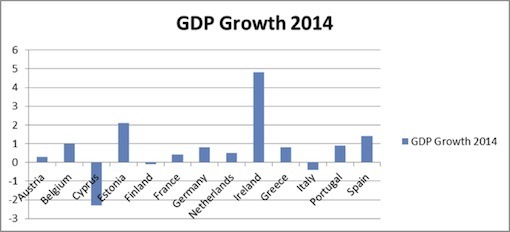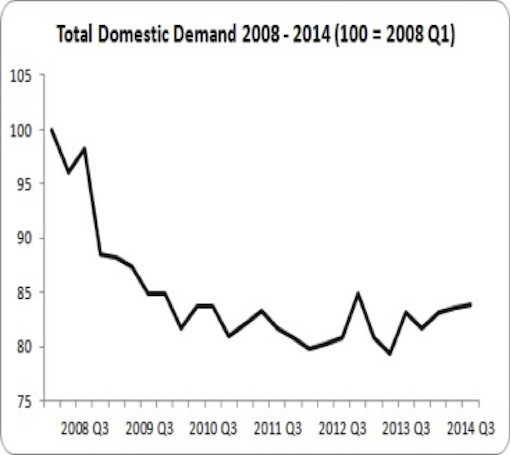Dublin, Ireland.
Have you heard the news? Dear old Ireland is in the midst of a great economic recovery. Well, that’s according to the government, the mainstream media, the multinational sector and even Angela Merkel. Yes, one by one they have been lining up to cheer on the poster boy of European austerity. Their hearty tale goes something like this; after experiencing one of the greatest economic shocks in history, Ireland having swallowed the austere medicine mandated by the Troika became – in defiance of all economic logic – the fastest growing economy in Europe (see graph 1 of Eurostat data).

Our Prime Minister Enda Kenny talks of a ‘Celtic Phoenix’ rising from the ashes. The domestic and international media have been crowing ‘Ireland is on the way back’, ‘Economic recovery keeps on motoring’ and ‘Ireland shows struggling Europe the way ahead’. The multinationals (MNCs) think things are going so well we should be giving the rich tax cuts again – something the government is all for. Whilst Angela Merkel has credited us as a ‘tremendous success story’ – one the austerity averse Greeks should be emulating.
But alas, this is just one version of events, and there is certainly another, albeit a less publicised and more depressing account. This is what could be described as the everyday experience of ordinary Irish people. It’s by no means the tale of triumph over adversity that the government are trumpeting. On the contrary, it is one of ongoing economic hardship, tragedy and farce.
The supposed ‘recovery’ that our leaders are harping on about is completely alien to the hundreds of thousands of ordinary people who have been consistently taking to the streets to protest against their policies. It’s alien to the ever growing number of people who are in long term mortgage arrears and face losing their homes, or to the people who have already lost theirs. And it’s alien to 10,000 people who just this month snapped up the entire allocation of work visas for Canada in less than 12 minutes, therein joining the 170,000 of our young people who have left since 2010.
So how do we reconcile these two contrasting/conflicting accounts? Could it be the case that a recovery is indeed underway but has yet to ‘trickle’ down to all sectors of the economy? Or is deprivation and stagnation a harsh reality which is merely being hidden by headline growth figures which just don’t add up?
Pliable Stats vs Stubborn Facts
The government are quick to point to our growth figures of 4.8% GDP and 4% GNP, but what does this really tell us? In short, not much. Ireland’s unique position in the global tax avoidance operation has rendered the standard economic indicator of GDP (gross domestic product) useless as measures of the health of the economy. It’s been well documented that the profit shifting activities of the multinational sector (MNCs) based here leads to massive distortions in this statistical indicator. So our politicians, analysts and commentators turned to GNP (gross national product) for a more accurate picture of the economy’s health.
But GNP is just GDP after we control for all the money that is flowing in and out of the country in a given period – and it too suffers from the same kind of distortions from MNCs profit shifting. Take for example the case of management consultancy firm Accenture who, along with several other big international groups, chose to relocate their headquarters to Ireland.
Now such ‘headquarters’ might consist of a small office with a single phone in it (see: Brassplate Company), which might lead you to believe makes it of zero consequence to domestic economy – but you’d be wrong. Even if such firms engage in no economic activity beyond their one roomed office, their massive profits are still recorded in the national accounts (GDP and GNP).
Then there’s issue of the major financial institutions located in the Irish Financial Services Centre (IFSC) which are currently managing some of the world’s largest investment funds. The Irish Funds Industry Association (IFA) recently announced that ‘Assets domiciled in Ireland in 2014 have reached a new high of €1.6 trillion‘. This is worth more than the entire value of all final goods and services produced in Australia last year.
And whilst you might be thinking that sounds great, the effect on the real economy has been negligible – aside from the distortions to our GNP. But don’t take my word for it, it was the Central Bank that stated ‘Financial Sector developments, which are for the most part unrelated to the domestic economy, account for a significant portion of the rise in GNP’.
So right about now you might be feeling like GDP and GNP offer us no great insight into the health of the real Irish economy, but let me tell, it gets worse. The methodology by which the national accounts (GDP and GNP) are compiled was recently changed to inflate the figures. How did they do this? Well, now goods that are not even being made here are being counted as if they were.
Once again it’s the Irish Central Bank we can thank for drawing our attention to this little peculiarity as they point out that ‘goods owned by an Irish entity that are manufactured in and shipped from a foreign country are now recorded as Irish exports’. In other words, goods that never saw Irish soil or touched the hands of Irish workers are being recorded as if they were one of our exports. The only criteria being that they are owned by an ‘Irish entity’. A term so elastic it can be stretched to fit just about any purpose. I’d say you couldn’t make this stuff up, but it appears somebody already has.
The Slow Death of Domestic Demand
The only means of comprehending the true health of the economy is to look at domestic demand – or what’s left of it. Domestic demand, which makes up about three quarters of the economy, is comprised of government investment and expenditure on public services and consumer spending. Thus it doesn’t suffer from the kind of distortions attributable to the MNCs that the likes of GDP or GNP does.
The two graphs below illustrate perfectly the superficial nature of this ‘recovery’. As we can see domestic demand fell off a cliff in 2008 and has pretty much remained there. Consumer spending – which is the largest component of domestic demand – is actually below 2009 levels. Given that disposable income has fallen by 20% since 2008, largely as a result of falling wages, rising taxes and cuts to welfare spending (in other words austerity), is it any wonder that the Irish Small and Medium Size Enterprise Association (ISME) just this month described the government’s recovery as ‘glacially slow and patchy’. But surely this was to be expected? If you depress people’s incomes to breaking point where’s your demand going to come from? And if you’ve got no demand, then you’ve got recovery.
The fact of the matter is you can’t tax and cut your way out of a recession in the same way that you can’t diet and starve your way out of a famine. But with over half a million Irish people now experiencing food poverty – try telling the government that.


A very ‘Irish’ Recovery
Have you ever heard the expression ‘that’s a bit Irish’? Collins English dictionary defines ‘Irish’ – in its adjective form – as something ‘ludicrous or illogical’. Well, judging by that standard, this is a very ‘Irish’ recovery.
Oh sure, there’s been a recovery for some. Ireland’s richest 250 individuals saw their combined wealth increase by 16% to a whopping 75 billion in the last year alone, so it’s fair to say they’re doing ok. Then there’s the multinationals, whose massive profits continue to enjoy de facto tax immunity. And things are even looking up for the politicians, who are planning to give themselves a pay increase as recognition for masterminding this great ‘recovery’.
Call me old fashioned if you will, but to me a recovery isn’t a recovery until the lives of the people who make up the bulk of that economy start to improve. We still seem a long way away from that point. And for that reason most Irish people don’t believe in this recovery; because they don’t see it and they certainly don’t feel it.
Cillian Doyle is an economist with the People Before Profit Alliance of Ireland.